
The First and Only Weekly Online Fanzine Devoted to the Life and Works of Edgar Rice Burroughs |
 |

The First and Only Weekly Online Fanzine Devoted to the Life and Works of Edgar Rice Burroughs |
 |
|
Chattering From The Shoulder #34 |
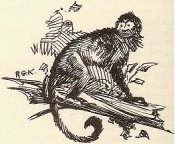 |
Arthur Adams |

NOTE:
Tarzan the Untamed cover art and St. John interiors may be found at:
ERBzine 0493: ERB C.H.A.S.E.R. Tarzan the Untamed
ERBzine 0124. TU St. John Art Gallery Pt. 1 with Commentary by David Adams
ERBzine 0125. St. John Art Gallery Pt. 2 with Commentary by David Adams

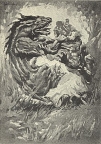
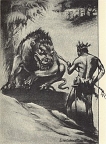

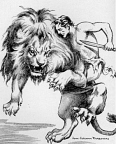

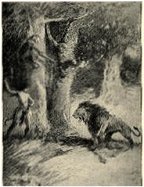

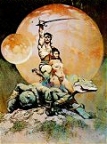
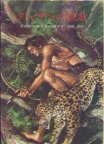





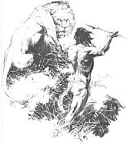

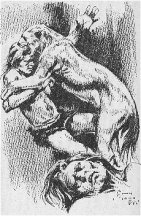
 
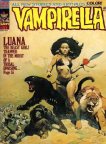

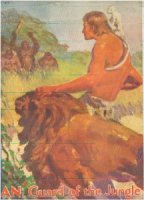
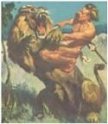
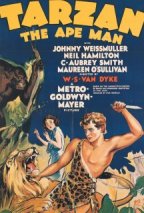 |
 On August 22, 1937, the Sunday Magazine of the Los Angeles Times published an article by Edgar Rice Burroughs called, "Man-Eaters." In this piece, Burroughs talks about his personal experiences with various movie lions on the MGM lot, and he mentions three famous books on the lion:
It is likely that Burroughs did a good deal of reading about lions while he was making his "corrections" for Tarzan of the Apes, which most likely included all of the books mentioned in his later newspaper article. According to Peter Hathaway Capstick’s "Editor’s Note to the Reprint Edition" of 1987, The Book of the Lion by Pease is considered by some (including the immortal hunter Denis Lyell) to be one of the best books ever published on the subject. It is one of the classic early accounts of lion hunting that includes first-hand observations that are both entertaining and informative. There can be little doubt that Burroughs found a wealth of material on lions in this book and many others. The focus of attention of this article is upon "Appendix I. The Lion in Ancient History," which was certain to have caught ERB’s curiosity. Pease begins his appendix with this paragraph: "Among many of the nations of Europe, Asia, and Africa, the lion in ancient times was raised to the position of a divinity. He was often worshipped as a god or venerated as a sacred creature, and he was to the fore in the earliest collections of tamed and untamed wild beasts. He became the companion of not a few emperors and kings. He was trained to fight in battles and to pursue and kill game for his masters." (Pease, 259).To the reader of ERB’s Tarzan novels, this sounds almost like the beginning of a story-outline. The placing of lions in elevated positions or describing their use as tamed fighting and/or hunting beasts is a common theme in many of the famous stories. Whether Burroughs got his idea for tamed/trained lions from Pease, or from nothing more than an ordinary lion-taming act at a circus, it is certain that he was fascinated with the possibilities enough to include them in his novels. Of course, Tarzan’s close relationship with animals precludes the extraordinary nature of his efforts; yet even he had troubles with lions, which had to be man-handled and bullied to do his bidding until he raised one from a cub. It is interesting that "the lad" in his 1914 story The Lad and the Lion makes friends with a male lion before Tarzan does in Tarzan the Untamed in 1918. (Even earlier, we might site the case of Thuvia, who effectively controls the Barsoomian lion, the banth, in The Gods of Mars of 1912.) Burroughs' usual method of animal training involves a large amount of kindness and understanding rather than brute force. John Carter tames the thoat with quiet words and a calm approach rather than simply bashing them between the ears, which was the usual Barsoomian method of control. (Princess, chapter 13 ). "My experience with Woola determined me to attempt the experiment of kindness in my treatment of my thoats. First I taught them that they could not unseat me, and even rapped them sharply between the ears to impress upon them my authority and mastery. Then, by degrees, I won their confidence in much the same manner as I had adopted countless times with my many mundane mounts. I was ever a good hand with animals, and by inclination, as well as because it brought more lasting and satisfactory results, I was always kind and humane in my dealings with the lower orders" (PM, 129)In real life, Ed was noted as a great horse tamer using this method. He was an early "horse whisperer," who had great successes this way, but he probably got the idea from reading the life of Alexander the Great. "On arrival in Macedonia, Bucephalas was led out into the plain for Philip’s inspection, but he bucked and reared and refused to heed any word of command, and Philip ordered him to be taken away. Alexander had seen differently. Promising to master the animal, he ran towards him, took him by the halter and turned him towards the sun, by a plausible trick of horsemanship, he had noticed that Bucephalas was shying at his own shadow, so he patted, stroked and soothed, lept astride and finally cantered around to shouts of applause from the courtiers and tears of joy from Philip, who is said to have predicted that Macedonia would never contain such a prince. Bucephalas was Alexander’s for the keeping, and he loved the horse for the next twenty years; he even taught him to kneel in full harness before him, so that he could mount him more easily in armour, a trick which the Greeks first learnt from the Persians" (Fox, 35).A good account of Burroughs’ methods of animal training can be found in chapter 2 of Phil Burger's Master’s thesis, "Glimpses of a World Past." He mentions the man-killing horse, "Whiskey Jack" that he tamed then treated with kindness, which later became his friend. Burger also covers the horse training methods of Julian in The Moon Men; Thomas Billings in The People That Time Forgot; along with John Carter's training of Woola, the Barsoomian dog; and Tarzan's way with Tantor. These stories all serve to set the foundation of Burroughs' lion taming plots, which is the main subject of this article. Tarzan befriended many animals throughout his life, but the process of taming lions went through various stages before his famous success with Jad-bal-ja, the golden lion. In the 1918 novel, Tarzan the Untamed, Burroughs uses a man-eating lion to kill Germans in the trenches, but this one was merely a beast driven by fear of the Ape-Man. There is a second lion later in the story, a black lion who is saved from a native pit, which like in the story of "Androcles and the Lion" is grateful and becomes at least a team-player. In fact, Tarzan and the black lion kill a pair of other lions, working together in a team effort. Later, this same lion chases Tarzan into the mad city of Xuja, but upon discovering his mistake he searches for his friend and helps in the penultimate escape. The first case in the Tarzan series of a society with tamed lions as servants is in this mad city of Xuja in the third section of Tarzan the Untamed. The citizens of Xuja are crazy, but they do have lucid moments of apparent sanity. Burroughs notes that they have been isolated for a long time and have inbred to the point of becoming imbecilic. The Xujans live with trained lions, a type we meet again in Tarzan and the City of Gold. Tarzan does not think much of these lions, calling them, "Cowards . . . Numa with a heart of Bara, the deer" (Untamed, 212). The lions in this case are not deities, but are used as guards and for food. Some of them are raised like cattle, fed on deer and swine, which one would imagine would have made a better meal than the cats. Later, in 1922, Tarzan raises Jad-bal-ja from his cubhood, and makes a companion who will save him again and again in his subsequent adventures. However, the theme of the lion raised to deity also occurs in Tarzan and the Golden Lion. This Numa (ERB's name for a male lion) is the Emperor of the Bolgani (gorillas) who live in the Palace of Diamonds, which is a citadel south of Opar. Brueckel and Harwood conjecture that these Bolgani (who merely look like gorillas, but have the brain of Man) were the descendants of a race of pithecanthropoids. They seem to have been carrying on the ways of their erstwhile masters who have long ago passed from the scene of history. The religion of these people revered a lion as a kind of god-king (Brueckel, 31-35). We have finally come to a point where "Appendix I: The Lion in Ancient History" of Pease's book comes into the story. Pease records the fact that: "In Egypt lions were worshipped at Leontopolis and Heliopolis. At Heliopolis the sacred lion lived in the Temple of the Sun (Ammon Ra); his food was most carefully selected, and sacred melodies were played to him during his meals" (Pease, 259.)Both Burroughs and Brueckel link Opar with the lost civilization of Atlantis, but the more mundane linking of Peace's statement above may have been the Idea that led ERB to write of the lion-god of the Bolgani. The sun-worshiping Egyptians with a lion on the throne certainly does bear some merit in this conjecture since the Oparians also worshiped the sun. Brueckel also notes the possibility of a religious splinter group as the original builders of the Palace of Diamonds, yet he says that its origin must remain largely a riddle. (Brueckel, 34). Brueckel also links the mad city of Xuja with Opar and notes that although the lions are not shown the same reverence as in the Palace of Diamonds, "the Xujan kings have had lionesses enthroned beside them as 'queens.' Not improbably, the lion once held a much more elevated station in Xujan society and was originally regarded, like the parrot or the eagle, as in some sense representative of deity" (Brueckel, 41-42). In Tarzan and the Golden Lion, the Ape-Man asks himself, "Why this topsy-turvy arrangement of species? What did he (Numa) represent? Here man ranked lower than the half-beast, and above all, from the deference that had been accorded him, stood a true beast - - a savage carnivore" (Golden Lion, 155). I suggested a symbolic meaning for this arrangement in my article called "A Crowning Achievement" in the Burroughs Bulletin #32, Fall 1997, yet this present article demonstrates that there may also be a historical basis for this arrangement -- the lions of Egypt at Heliopolis, which Burroughs read about in The Book of the Lion by Pease. Tarzan replaces this false lion god of the Bolgani with Jad-bal-ja, whom he calls, "Numa, King of Beasts, Emperor of All Created Things." (Golden Lion, 214). In the battle that follows, the Gomangani, who have been the slaves of the Bolgani for countless ages, are freed. The Bolgani return with Tarzan and La to help her regain her throne in Opar, which has been usurped by the traitorous, Cadj, the High Priest. Thus, the hero plays a favorite role in the novels of Burroughs -- the exposing of a false religion which is exploiting a people and replacing it with an arrangement of his own. The effects of this cultural managing is portrayed as an improvement in the societies in which it occurs. This interference in the religious and social mores of an ancient culture was of course entirely acceptable at the time the stories were written, and Tarzan did free a people, the Gomangani, who had been bound in slavery. In Tarzan and the City of Gold, written in 1931, the Cathneans raise lions for war and hunting. There are 500 adult male lions in Cathne, 300 of which are owned by the mad queen, Nemone, and the rest by the Lion Men, Cathne's hereditary nobles (Brady, 64). Brueckel places Cathne, the City of Gold, along with its rival city, Athne, the City of Ivory, on the Abyssinian plateau in Ethiopia. Although these lost cities are difficult to place with precision, he thinks it highly probable that they lie in the high mountains just east of the string of lakes between Adis Ababa and Lake Rudolph. Their origin may be offshoots of civilizations of the eastern Mediterranean region -- Egypt, Greece, Sabaea, Phoenicia, Judah-Israel -- but it is also quite conceivable that their beginnings go back to the great central African empire which built Opar. (Brueckel, 45). In Cathne a lion is indeed elevated to the status of a deity, even though it is an old, mangy one called Thoos, who is fed human sacrifices during temple ceremonies. Brueckel, who is the expert in these matters, thinks that he hears an an echo of religion of dead Atlantis in the emphasis upon lions and gold, both sun symbols. "The Cathnean lion-god Thoos reminds us of Numa, god-king of the Bolgani and their vanished predecessors of the Palace of Diamonds, and the Cathneans' breeding and training of lions for hunting and war recalls the precisely similar custom of the madmen of Xuja" (Brueckel, 47). He also points out that the rivalry between Cathne and Athne may have developed over a difference in religious beliefs since the Athneans hold the elephant as the symbol of deity rather than the lion. According to Pease, lions were used for both hunting and war in ancient Egypt, which again may have been Burroughs’ inspiration for Cathne. "The Egyptians not only tamed, but trained, wild beasts to an extent and with a thoroughness that must appear to us very remarkable. Wild cats, cheetahs, leopards, striped hyenas, wild dogs (Lycaon), and lions were all trained for the chase." "After the XIIth dynasty (or between 3000 and 2000 B.C. we no longer find Hyaena and Lycaon used for hunting, but between 1700 and 100 B.C., after the XVIIIth and XIXth Dynasties, the lions and cheetahs continue to be used in the packs of hunting-beasts. In Egypt, as in Assyria, the lions were usually shaved, and were also used in war. Rameses II (XIXth dynasty) was accompanied to battle by his lion Anta-m-nekht, who went in front of his chariot alongside the horses and struck down with a blow of his paw any one who came near" (Pease, 259-260).Perhaps even Jad-bal-ja's name had its origin in the hyphenated name of Rameses' lion. Pease's historical account of lions is a long one. He gives credit to Gustave Loisel's "Histoire des Menageries de l'Antiquite a nos jours" (3 vols) for his information, and refers the reader to this source for checking historical accuracy and for further information in a Bibliographical Index. Pease mentions a procession under Ptolemy in which lions were employed to pull 12 cars, which reminds us of the chariots of Cathne, which were also drawn by lions. Without a doubt Burroughs investigated many authorities about lions as he continued writing his Tarzan Series. Sir Alfred Pease's The Book of the Lion must be onsidered a primary source, and it seems likely that the information he gathered from this book was one of the inspirations for some of his leonine plots. 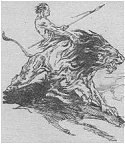 |
BibliographyBrady, Clark A., The Burroughs Cyclopaedia, McFarland, 1996.
Brueckel, Frank J. and Harwood, John, Heritage of the Flaming God: An Essay on the History of Opar and Its Relationship to Other Ancient Cultures, Waziri Publications, 1999.
Burger, Phil, "Glimpses of a World Past: Edgar Rice Burroughs, the West, and the Birth of an American Writer," Utah State University, 1987.
Burroughs, Edgar Rice, A Princess of Mars, G&D.
---------- Tarzan the Untamed, G&D.
---------- Tarzan and the Golden Lion, G&D.
Fox, Robin, Alexander the Great, Folio Society, 1999.
Pease, Sir Alfred, E., The Book of the Lion, St. Martin's Press, 1987.
July 23-24, 2000
Web References in the ERB Cosmos
ERBzine 0447 Nkima Chat #16: Edgar & Lions
ERBzine 0240: Numa's Lair Pt. 1
ERBzine 0448: Numa's Lair Pt. 2
ERBzine0449 Nkima Chat #17: Lad & Lion Pt. I
ERBzine 0450 ERB's First Film: Lad & Lion
ERB C.H.A.S.E.R. Online Encyclopedia
Visit
David "Nkima" Adams'
ERBzine homepage
ERBzine 0396
to see the navigation chart of all of his
Chattering From the Shoulder columns
and other appearances in the Hillman ERB Cosmos
